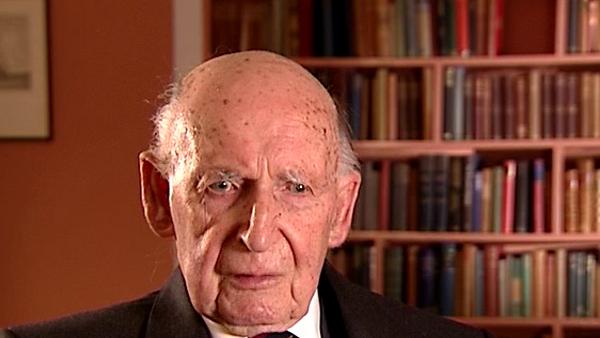NEXT STORY

Communicating via the Moon
RELATED STORIES

NEXT STORY

Communicating via the Moon
RELATED STORIES



I thought at that time that, you know, people were not really convinced that the integration of the radio records could be regarded as suspicious, and then we... when... when we developed the MERLIN System, with phase correlation, I... I joined forces with Palmer in the observation of... radio observation of one of the stars. And this Professor Mavridis in Greece also had a splendid apparatus for recording optically the... the flares from these stars, and we then obtained something which was really magnificently conclusive. Mavrodis found quite a big flare and simultaneously on this... with the... with the telescope linked, phase linked to one of the... what became MERLIN telescopes, we had a... a magnificent radio record absolutely co-incident with the radio flare.
Now, I must be moving now into the 1970s and the odd thing is that I had... I had by that time a couple of students working with me, one of whom subsequently went to... to America and continued to work there and a person, my very last student who took a PhD when I was still director and the last paper with which I was associated on... on these flare stars was published as a matter of fact, I think, after I had officially retired and oddly enough it didn't just have my name and one or two of my associates on it, but I think it was a combined paper of 15 or 20 observers because it was a relation of the flare stars over the whole spectrum, the x-ray spectrum, the optical spectrum, to the radio spectrum.
I don't think that the... the observation of these stars... they... they never became particularly popular, the cosmological problem and the study of quasars and the remote parts of the universe understandably and quite naturally began to ascend to the important objects to be studied, but I... Anyhow, the... that became my main scientific interest during the working life of the telescope, as well as... as long as I was director. I, with the development of computers and the new systems, which were then occurring at Jodrell Bank... I would quite liked to have continued that work after I retired but to be perfectly frank, the demands on the telescopes were so great that I thought it would be quite wrong of me to express any particular pressure to allow myself to do that after I'd retired so I... I really did finish my flare star work then, although I've still been interested in the results that occur. A number of papers I wrote on that, I gave my presidential address to the Royal Astronomical Society on the subject and the... the theory of the optical flares and of the radio flares is... is in that paper.
The important point about the flares of these red dwarf stars is that they are extremely powerful. We... we associated it with the violent solar flares and radio emission from the flares from the sun but the... the flares on the M type dwarfs are of far greater intensity, and there... there is... I had one of the theorists in the university working on this problem and he did publish a paper on... dealing with this problem and of the origin of this radio emission in the atmosphere of the red dwarf stars. I also became interested that K-stars might be radio emitters, but never succeeded in pursuing that work very much, although there is a paper in the... which I wrote in the philosophical transactions of the Royal Society, which deal with the magnitude of the radio emission from the M-dwarfs and the possibility of K-stars, also powerful emitters. They do have a certain relevance today to this search, which seems to occupy a lot of attention for intelligent signals from planets which are now known to be in orbit around some of the stars. And I don't think people realise that some of the stars they're hoping to find planets around on which there might be some form of intelligent life, any such intelligent life such as we have would be completely extinguished by this powerful emission from... from the... from the parent star.
Bernard Lovell (1913-2012), British radio astronomer and founder of the Jodrell Bank Observatory, received an OBE in 1946 for his work on radar, and was knighted in 1961 for his contribution to the development of radio astronomy. He obtained a PhD in 1936 at the University of Bristol. His steerable radio telescope, which tracked Sputnik across the sky, is now named the Lovell telescope.
Title: Final work on flare stars
Listeners: Megan Argo Alastair Gunn
Megan Argo is an astronomer at the University of Manchester's Jodrell Bank Observatory researching supernovae and star formation in nearby starburst galaxies. As well as research, she is involved with events in the Observatory's Visitor Centre explaining both astronomy and the history of the Observatory to the public.
Alastair Gunn is an astrophysicist at Jodrell Bank Observatory, University of Manchester. He is responsible for the coordination and execution of international radio astronomical observations at the institute and his professional research concerns the extended atmospheres of highly active binary stars. Alastair has a deep interest and knowledge of the history of radio astronomy in general and of Jodrell Bank in particular. He has written extensively about Jodrell Bank's history.
Tags: Greece, Jodrell Bank, Royal Astronomical Society, H P Palmer
Duration: 6 minutes, 6 seconds
Date story recorded: January 2007
Date story went live: 05 September 2008